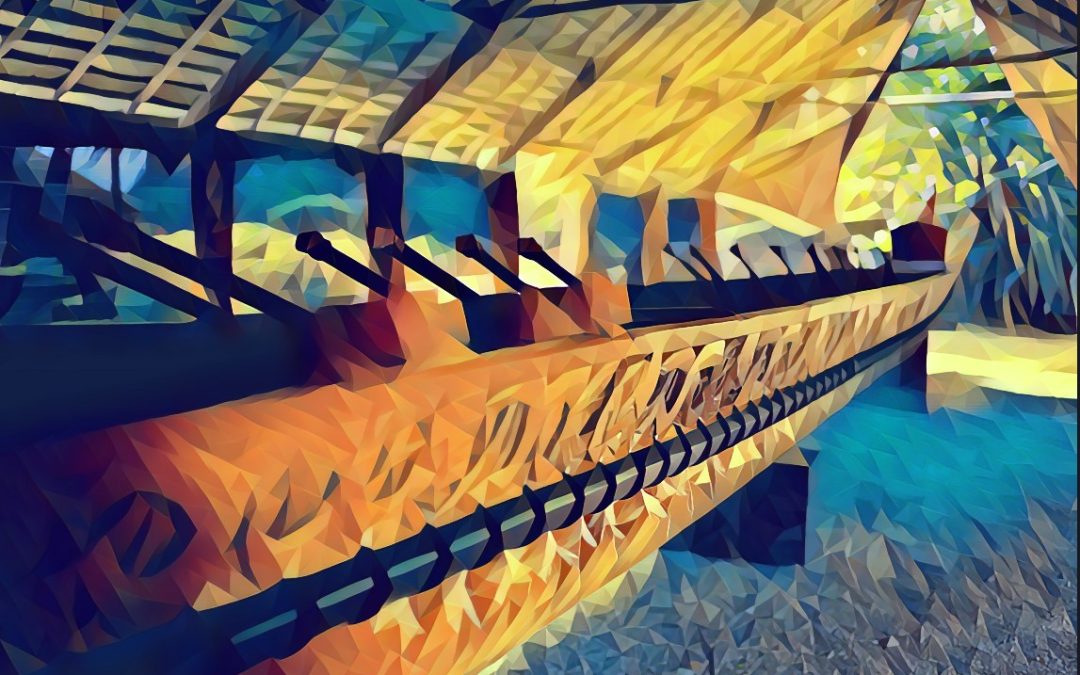Note: Different Māori communities have varying adaptations of this legend. We respectfully submit a version based off of Chapter 7 from the 1855 publication POLYNESIAN MYTHOLOGY & ANCIENT TRADITIONAL HISTORY OF THE NEW ZEALANDERS AS FURNISHED BY THEIR PRIESTS AND CHIEFS, by Sir George Grey.
Rata was born to Wahieroa, son of the God Tawhaki, and Wahieroa’s wife, Kura. His father was killed by his enemy when Rata was but a boy, and thus Rata grew with the understanding that one day he must avenge his father’s death. When he reached manhood, he exclaimed to his village that, “I am about to go in search of the man who slew my father.” After he exacted his revenge, he knew that he must find the bones of his father and return them to his ancestral home.
His plan required a strong canoe for the journey for him and his warriors. He went into the forest where he found a mighty tree which stood tall and straight.
After cutting it down, he worked to remove the limbs. This great tree housed many insects and birds, and its destruction made the forest spirits angry. He did not perform the sacred chants; he did not seek permission from the inhabitants of the forest. They banded together to repair the tree, down to the very last cut and shaving.
As they worked, they sang the following chant:
“Fly together, chips and shavings, Stick ye fast together. Hold ye fast together; Stand upright again, 0 tree!”
When Rata returned the next morning, he looked for the tree which he had cut down, but it was nowhere to be found. As he looked up, he saw another tall and mighty tree. Could it be that it had been restored? He went to work again, cutting, removing limbs, and pulling off the bark. He began to form the bow when night fell, and he decided to return to his village until dawn. Once again, the spirits restored the great tree.
In the morning he found that the tree was once again tall and mighty. He set to work one more time to fall the great trunk. Then he pretended to leave, but actually he hid himself low to the ground in the brush. Soon the spirits, who called themselves the children of Tane, returned to repair the bugs and bird’s precious home.
Rata ran up, grabbing some of them, demanding to know why they were back once again to stop his work.
“Who gave you authority to cut our forest god to the ground? You do not have the right!” the spirits shouted.
Rata was greatly ashamed of his thoughtless act. The spirits, bugs and birds decided to forgive him. “Return, to your village, Rata, and we will make a canoe for you.” Soon they were able to present him with a beautiful and sturdy canoe that could hold 140 warriors. He named the vessel Riwaru, as it bore him and his men into battle with honor.
Read about the beautiful and intricately carved waka taua (war canoe), prepared for a king, and donated to the Polynesian Cultural Center in 1960s.
Bio of Nina S. Jones, Blogger for the Polynesian Culture Center

Nina Jones, a mainland gal from way back, is now a transplanted Islander. With her husband of 39 years, she volunteers at the Polynesian Cultural Center. Her hobbies include swimming, traveling, studying and writing about what she is learning from the various Polynesian cultures. Her blogs focus on their history, beliefs, practices and – as an added bonus – delicious food! To her, Polynesia is not just a place to visit, it is a way to live and she is very honored to be able to be a part of their amazing world.


Recent Comments